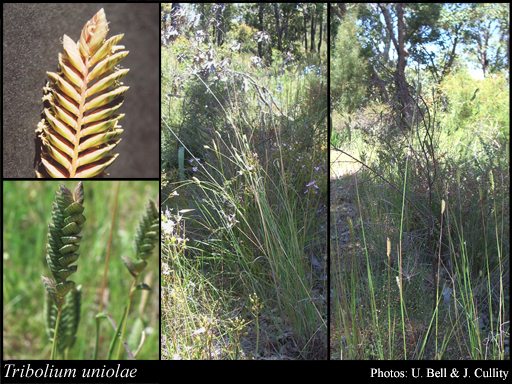- Reference
- Kew Bull. 40:797 (1985)
- Conservation Code
- Not threatened
- Naturalised Status
- Alien to Western Australia
- Name Status
- Current
Tufted straggly perennial, grass-like or herb, 0.1-0.3(-0.6) m high. Fl. green/purple, Oct to Dec. Sand, sandy clay, gravelly laterite.

Distribution
- IBRA Regions
- Esperance Plains, Jarrah Forest, Swan Coastal Plain.
- IBRA Subregions
- Northern Jarrah Forest, Perth, Recherche, Southern Jarrah Forest.
- Local Government Areas (LGAs)
- Armadale, Esperance, Gosnells, Harvey, Kalamunda, Mundaring, Plantagenet, Swan, Waroona.
Management Notes (for the Swan NRM Region)
Alternative Names. Haas grass, Tribolium, hare grass, wheat grass.
General Biology. Growth form. Grass. Life form. Perennial, caespitose/shortly rhizomatous. Reproduction. Seed, also short rhizomes. Dispersal. Water, wind, ants, soil, road grading, contaminated soil movement. Photosynthetic Pathway. C3. Fire response. Resprouts, prolific seed germination.
Notes. Highly invasive and has the potential to seriously impact native plant communities across its invasive range. Forms dense clumps. Capable of displacing herbaceous flora. Prefers clay-based soils and lateritic gravels. Is a variable taxa in its native range, with different forms being associated with differences in soil type and altitude. Studies suggest this is the result of hybrisation with the closely related but more restricted Tribolium brachystachum. Although plants may reproduce clonally from small perenniating buds breaking off from the base, it mainly reproduces and spreads by mildly dehiscent seeds. Seeds have no obvious features for dispersal apart from being lightweight and of small size. Seedling survival appears to be highest in wetter habitats such as creek lines. Appears to proliferate following fire, with fire playing a significant role in its expansion into bushland.
Additional information. Origin. South Africa. History of use/introduction. Pasture grass.
Suggested method of management and control. Spot spray with glyphosate 10 ml/L or Fusilade® Forte 19 ml/L + wetting or for generic fluazifop-p (212g/L active ingredient) 12ml/L + wetting agent prior to boot stage. Spot spray resprouting clumps and blanket spray seedling flushes with Fusilade® Forte 16 ml/L + wetting agent or for generic fluazifop-p (212g/L active ingredient) 10ml/L. Smaller plants and isolated infestations may be physically removed or cut at the base with a sharp knife when the soil is moist. However, as small perennating buds can result in new plants care needs to be taken during any hand removal program. Larger plants are difficult to remove in their entirety without causing excess soil disturbance. Following any fire event is an optimal time to undertake control. Read the manufacturers' labels and material safety data sheets before using herbicides. For further information consult the Australian Pesticides and Veterinary Medicines Authority to determine the status of permits for your situation or state.
Management Calendar
| Calendar Type | Jan | Feb | Mar | Apr | May | Jun | Jul | Aug | Sep | Oct | Nov | Dec | Comments |
|---|---|---|---|---|---|---|---|---|---|---|---|---|---|
| Dormant | Y | Y | Y | Y | O | O | |||||||
| Active Growth | Y | Y | Y | Y | Y | Y | |||||||
| Germination | Y | Y | |||||||||||
| Flowering | Y | Y | |||||||||||
| Fruiting | O | Y | |||||||||||
| Manual Removal | Y | Y | Y | Y | Y | Y | Y | ||||||
| Herbicide Treatment | Y | Y | Y |
Legend: Y = Yes, regularly, O = Occasionally, U = Uncertain, referred by others but not confirmed.
References
- Bettink, K. (2008) Haas grass (Tribolium uniolae), Bushland Weeds. Urban Nature, Department of Environment and Conservation, Western Australia.
- Bettink, K.A. (2008) Haas Grass (Tribolium uniolae), Draft strategic plan for the Swan NRM Region. Swan Catchment Council and Department of Environment and Conservation, Perth, Western Australia.
- Brown, K. & Brooks, K. (2002) Bushland Weeds: A Practical Guide to their Management. Environmental Weeds Action Network, Greenwood.
- Brown, K. & Brooks, K. (2003) Management of the South African grass Tribolium uniolae (L.f.) Renvoize invading threatened ecological communities in the Brixton Street wetlands. Plant Protection Quarterly, 18 (3): 99.
- Brown, K. & Brooks, K. (2005) Notes on the biology and ecology of Tribolium uniolae (L.f.) Renvoize and its spread in south-western Australia. Plant Protection Quarterly, 20 (2).
- Hussey, B.M.J., Keighery, G.J., Dodd, J., Lloyd, S.G. & Cousens, R.D. (2007) Western Weeds. A guide to the weeds of Western Australia. 2nd Edition. The Plant Protection Society of Western Australia, Victoria Park.
- Linder, H.P. & Davidse, G. (1997) The systematics of Tribolium Desv. (Danthonieae: Poaceae). Botanische Jahrbücher für Systematik, 119: 445-507.
- Renvoize, S.A. (1985) A Review of Tribolium (Gramineae). Kew Bulletin, 40 (4): 795-799.
- Spies, J.J., Davidse, G. & du Plessis, H. (1992) Cytogenetic Studies in the Genus Tribolium (Poaceae: Arundineae). American Journal of Botany, 79 (6): 689-700.
- Watson, L., & Dallwitz, M.J. (2008) The Grass Genera of the World: Tribolium Desv. URL: http://delta-intkey.com/grass/www/triboliu.htm - Accessed Febraury 2010.